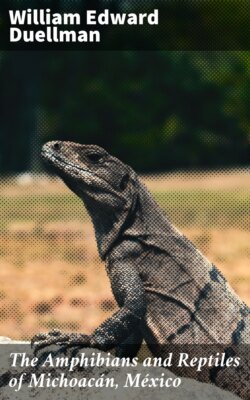Читать книгу The Amphibians and Reptiles of Michoacán, México - William Edward Duellman - Страница 7
На сайте Литреса книга снята с продажи.
Physiography
ОглавлениеTable of Contents
The state of Michoacán comprises an area of 60,093 square kilometers (Vivó, 1953). Within this area the rugged terrain has a total relief of nearly 4000 meters. There have been several attempts to classify the physiographic provinces of México; the classification used here is a slight modification of the scheme proposed by Tamayo (1949). I have tried to keep the system as simple as possible, but still useful in discussing the distribution of animals living in the region. For general purposes the state of Michoacán can be divided into lowlands and highlands as follows:
Lowlands
Pacific Coastal Plain
Balsas-Tepalcatepec Basin
Highlands
Mexican Plateau
Cordillera Volcánica
Sierra de Coalcomán
Although the lowlands in the state are continuous, they are only narrowly connected and thus form two distinct physiographic and biotic areas. The Pacific Coastal Plain in Michoacán extends for a distance of about 200 kilometers (airline) from the Río Coahuayana to the Río Balsas. The coastal plain is broad between the Río Coahuayana and San Juan de Lima, and between Las Peñas and the Río Balsas, where the hills rise some 12 kilometers inland from the sea. Between San Juan de Lima and Las Peñas the mountains extend to the sea; in this region rocky promontories form precipitous cliffs dropping into the sea. Between the promontories are small sandy or rocky beaches.
Lying to the north of the Sierra de Coalcomán and the Sierra del Sur, but south of the Cordillera Volcánica, is a broad structural depression, the Balsas-Tepalcatepec Basin. The western part of this basin, which separates the Sierra de Coalcomán from the Cordillera Volcánica, is the valley of the Río Tepalcatepec, a major tributary of the Río Balsas. The eastern part of the basin is the valley of the Río Balsas. From the point of junction of the two rivers, the Río Balsas flows southward through a narrow gorge, which separates the Sierra de Coalcomán from the Sierra del Sur, to the Pacific Ocean. In Michoacán the floor of the Balsas-Tepalcatepec Basin varies from 200 to 700 meters above sea level.
The central part of México is a vast table-land, the Mexican Plateau, the southern part of which extends into northern Michoacán. In this region the terrain is rolling and varies from 1500 to 1900 meters above sea level. Many small mountain ranges rise from the plateau and break the continuity of the rolling table-land. Located on the southern part of the Mexican Plateau in Michoacán are several lakes, the largest of which are Lago de Chapala, Lago de Cuitzeo, and Lago de Pátzcuaro.
Bordering the southern edge of the Mexican Plateau is a nearly unbroken chain of volcanos, the Cordillera Volcánica. The highest peaks in Michoacán, Cerro San Andrés (3930 meters) and Cerro de Tancítaro (3870 meters), are in this range. Parts of the Cordillera Volcánica in Michoacán are known by separate names; these are, from west to east: Sierra de los Tarascos, Sierra de Ozumatlán, and Serranía de Ucareo.
Lying between the Tepalcatepec Valley and the Pacific Ocean, and east of the Río Coahuayana and west of the Río Balsas, is an isolated highland mass, the Sierra de Coalcomán. This mountain range rises to elevations of slightly more than 3000 meters. It has a length of about 200 kilometers and a width of about 80 kilometers. Except for a relatively low connection with the Cordillera Volcánica, the Sierra de Coalcomán is isolated from other mountain ranges in southwestern México.
